|
|

|
Zundapp KS601 - Straightening Rear Axle
|
| |
| |
I had to remove the rear wheel to accommodate cleaning the incredibly tenacious crud off rim
and spokes and to give me better access to the stuff on the plungers, more like asphalt than
oil residue. Also, wanted to take a look at the final drive and brake shoes, although the
rear brakes have always been strong and silky smooth. So of course I loosen the clamp bolt
and turn the rear axle out.
One does not expect a 57 year old rear axle to simply slide out, but after getting it free
of the threads I was having an actual hell of a time getting it to move. I could push it out
about 1.5", but then it just jammed there. I'd oil what was accessible on both ends, thread it
all the way back in, then out again, repeat. Managed to achieve about 3" of play doing that
a number of times, but no further gains.
Finally, and very reluctantly, I had to resort to a big brass drift and drive the axle out with
a mongo hammer. I'd rotate it often as I went. Found a few positions that drove a bit easier,
but by this time it was evident it had a pretty good bend in it.
|
|
The Atlas Press
|
|
It took more force than I was happy with, but I did finally get the damned thing out.
It had a good sized bow in it, not quite centered but favoring the left side a bit.
My impression is that the bend started where the axle emerges from the left side of the
hub and makes its way, unsupported for maybe 2.5", to the left plunger casting.
My hope is this was someone doing sky shots with the bike, not just poor metallurgy.
Sky shot damage is preventable. That's what the V65 Sabres are for. The Zundapp will
enjoy a mellow peaceful existence.
Anyhow, time to introduce the axle to my 15 ton Atlas mandrel press, one of my most prized
possessions. This thing can put a truly impressive bit of force at the end of the ram.
With the Atlas, one does not worry about having insufficient force. One worries about
wrecking stuff before you're aware you're doing it. Although, compared to a hydraulic press,
you have great feedback pulling on the handle, you still need to respect the mechanical
advantage. I calculate that 105 Lbs at the end of the handle puts 15 tons at the end of
the ram when the handle is in the best position and set for compound leverage.
|
|
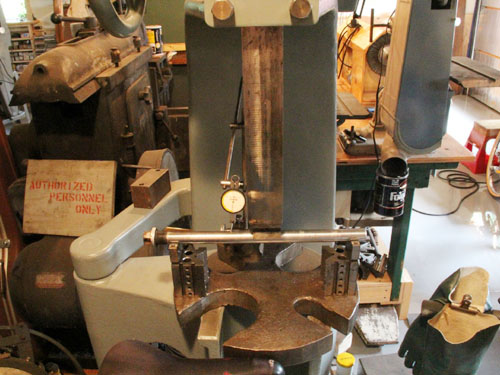
|
The KS601 rear axle, in the press and ready for a careful nudge.
|
|
Above, you see the basic setup for measuring the degree and location of the bend. Actually,
in that picture I'm about to give it a nudge, so the dial indicator is to show me how much
I'm deflecting it, and how much it springs back. There's a short V-block under the ram, and
copper shims between the axle and the V-blocks.
As an aside, notice the workbench behind the press. At lower right you see the nose of my
pallet jack poking out from under the bench. Most of the stuff in the right half of the
garage is set up to move quickly with the pallet jack; stereo and speakers, tool cabinet,
grinding bench, etc. This way I can use the right stall as a very flexible work space, then
clear it quick to get a car in there. Also, the pallet jack can effortlessly move all my
machinery, and you can jack up a car easily and shift it side to side in the stall, like
for pulling half axles.
In the summer, it takes literally a minute to move the grinding bench out the door to keep
the mess outside. Also, the pallet jack stores under the bench, as you see (part of it) here,
and takes up only about a foot of extra room when I'm not using it. Love that thing!
Anyhow...
|
|
Before And After...
|
|
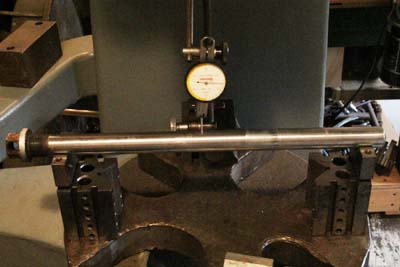
|
|
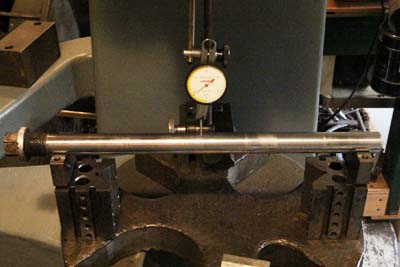
|
Above, left and right, you see the dial indicator measuring the amount the axle is bent.
The needle has wrapped around one full turn, 0.030", from the left to the right image,
so the total bend is 0.041", approaching 1/16" for those who don't speak in thousandths.
The trick is to work up slowly to the yield point of the axle. So I give it a nudge, then
release the pressure and see how far it springs back. A little harder nudge, release and
check. Since I didn't know the axle material I was very careful, creeping up on the yield
point incrementally.
To me, the axle was a bit softer than ideal, but not at all bad. By comparison, my Sabres'
axles are similar dimensions, but the Sabre weighs 593 Lbs wet, and I have launched them all
over railroad tracks and whatever presented itself for a take off ramp countless times.
Got 3' feet of air occasionally, although I might agree that's a bit much for a 600 lb
street bike, even though they seem to absorb it without complaint.
I did kind of hammer forge the ID of a rear wheel bearing mounting bore - in the aluminum wheel
casting - out to a larger dimension. I discovered this while searching for the cause of a 135
mph tank slapper I experienced decelerating after a race. Thought I was going to have to bail.
Glad 140 was enough to win the race or it would have happened at a higher speed yet. I usually
avoided (Note the past tense here. I am too old for that shit!) straight line races. Thrill to
risk ratio is all wrong, and it depends on someone letting off the throttle rather than being
decisively beaten in maneuvering. Well, that's all history, but good memories.
My point is, I never bent an axle, or anything else. That's a comment on the silent engineering
revolution so few folks are aware of, never mind appreciating its stunning impact on our lives.
Metallurgy! Henry Ford's use of vanadium steel in the Model T may arguably have been of more
importance than his implementation of the assembly line.
|
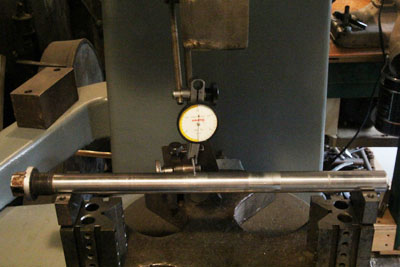
|
|
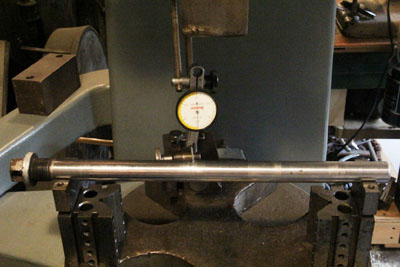
|
But back to the axle. Above left and right we see the dial indicator happily showing less than
a thousandth of bend left after straightening. The axle would yield kind of suddenly, and move
a few thousandths, so when I got it to this point I thought a touch under 0.001" is pretty
decent. I didn't want to keep working the damned thing back and forth, so I called it good.
|
|
|
Last updated 11-06-17
Email:
mechanique at wmol dot com
|

|
|
|





